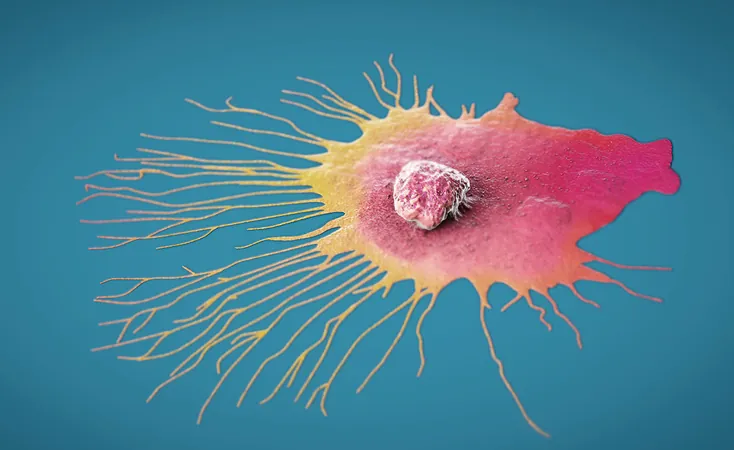
The Surprising Link Between Exercise and Neuron Growth Unveiled!
2024-11-16
Author: Ming
Exercise has long been celebrated for its myriad health benefits, from bolstering physical strength to enhancing cardiovascular wellness. However, recent groundbreaking research from a team of engineers at MIT reveals an astonishing new benefit: exercise directly stimulates the growth of neurons.
Led by Ritu Raman, an assistant professor of mechanical engineering at MIT, this study highlights how contracting muscles release specific biochemical signals known as myokines, which have a profound effect on neuronal development. When motor neurons were exposed to these signals, they exhibited a staggering fourfold increase in growth compared to those not exposed. This revelation has enormous implications for developing innovative therapies aimed at repairing and regenerating nerves.
The Muscle-Nerve Connection
This pivotal study is the first of its kind to provide concrete evidence that physical activity can incite neuron growth as effectively as biochemical signals produced by muscles. Prior studies hinted at a connection, but Raman's research takes it a step further, showcasing the significant interplay between both biochemical and physical influences.
Published in the journal Advanced Healthcare Materials, the research sheds light on the critical link between muscle and nerve health. This breakthrough could lead to new treatment avenues for restoring nerve function in individuals suffering from nerve injuries or neurodegenerative disorders.
“As we've discovered this muscle-nerve communication, there lies potential for therapeutic strategies for conditions like nerve injuries, where the vital connection between nerve and muscle is disrupted,” Raman explained.
Exploring the Influence of Muscles on Nerve Growth
In previous research, Raman's team successfully restored mobility in mice with severe muscle injuries by implanting new muscle tissues and stimulating them with light. This process led to the production of beneficial biochemicals that induced growth in blood vessels and nerves. These findings suggested that active muscle tissues could play a crucial role in nerve development, prompting Raman's team to delve deeper into whether muscle-generated signals might directly facilitate nerve growth.
To investigate this, they engineered muscle tissue from mice that contracted in response to light. By employing a specially designed gel mat that prevents detachment, the team stimulated muscle contractions, allowing them to collect a blend of myokines, which includes essential proteins and RNA. “Muscles release myokines even at rest, but this release dramatically increases during exercise,” Raman noted.
Promising Results from Myokine Exposure
The research team applied the myokine solution to brain-derived motor neurons cultivated from mouse stem cells. The results were impressive: neurons exposed to myokines grew four times faster and farther than those without exposure. Genetic analyses indicated that myokines activated genes not only related to neuron growth but also those linked to maturation and overall functionality.
Exercise doesn't just spur neuron growth; it also enhances neuron efficiency and interaction with other cells, which is crucial for proper nervous system function.
Mechanical Stimulation: A Game-Changer?
The researchers then pondered whether neurons could benefit from mechanical stimulation, independent of biochemical signals. Using a gel mat with embedded tiny magnets, they simulated mechanical stretching on another set of neurons. To their surprise, this method prompted neuron growth comparable to myokine stimulation, suggesting both biochemical and mechanical aspects of exercise are vital for neuronal development.
"This underscores that both the biochemical and physical impacts of exercise play equally significant roles," Raman emphasized.
Therapeutic Implications for Restoring Mobility
This discovery paves the way for new therapeutic approaches targeting nerve repair and treating neurodegenerative diseases like ALS. By harnessing the power of targeted muscle stimulation, researchers aim to develop novel treatments that could significantly improve outcomes for individuals affected by conditions that impair nerve function.
“This research is just the beginning of understanding and harnessing exercise as a form of medicine,” Raman stated.
As evidence mounts regarding the multifaceted benefits of exercise on nerve health, researchers are increasingly focused on exploring exercise-based therapies that could restore function and mobility in those grappling with nerve damage or degeneration. The potential for exercise to become a cornerstone of future neurotherapeutic strategies is indeed promising, highlighting a natural pathway toward healing and regeneration.
In a world where sedentary lifestyles are becoming the norm, the findings of this study serve as a powerful reminder of how vital regular exercise is—not only for our muscles but also for our brain health and wellbeing!



 Brasil (PT)
Brasil (PT)
 Canada (EN)
Canada (EN)
 Chile (ES)
Chile (ES)
 España (ES)
España (ES)
 France (FR)
France (FR)
 Hong Kong (EN)
Hong Kong (EN)
 Italia (IT)
Italia (IT)
 日本 (JA)
日本 (JA)
 Magyarország (HU)
Magyarország (HU)
 Norge (NO)
Norge (NO)
 Polska (PL)
Polska (PL)
 Schweiz (DE)
Schweiz (DE)
 Singapore (EN)
Singapore (EN)
 Sverige (SV)
Sverige (SV)
 Suomi (FI)
Suomi (FI)
 Türkiye (TR)
Türkiye (TR)